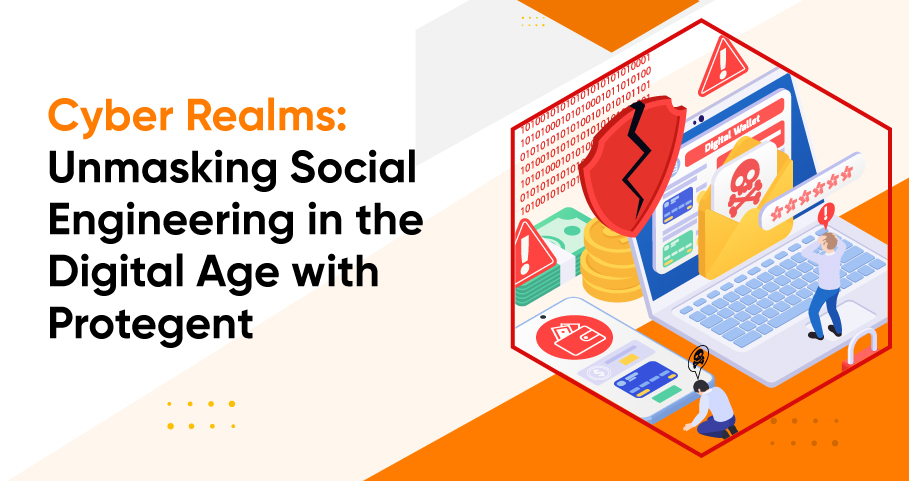
Unraveling the Intricacies of Social Engineering: Tactics, Risks, and Defenses with Protegent
What is Social Engineering?
Social engineering stands as a manipulation tactic where cybercriminals exploit human trust to acquire confidential information, paving the way for subsequent cybercrimes. By employing disguised communication, such as emails or calls, these malevolent actors deceive individuals into revealing passwords or personal details.
For instance, a cybercriminal may employ social engineering to coax an employee into disclosing company passwords. Armed with these credentials, the cybercriminal gains entry into corporate networks, executing data theft and installing malware on the company’s network.
The simplicity of this deceptive strategy lies in an email, phone call, or text message adeptly disguised as originating from a colleague, friend, or reputable company. The cybercriminal employs a familiar yet urgent tone, convincing the victim to update their banking information or coercing them to provide credit card details under the guise of claiming a prize.
Defending against social engineering proves challenging due to the unpredictability of human behavior and the potential for victims to be caught off-guard. Identifying who might succumb to a social engineering attack is an elusive task, as cybercriminals rely on catching their targets unaware, exploiting moments when vigilance against cyber threats falters.
What Motivates Cyber Criminals to Employ Social Engineering?
Cybercriminals leverage social engineering techniques for various motives, with one of the most prevalent being the quest for access to sensitive information. Acting as a legitimate company or individual, they employ trickery to extract login credentials, financial details, or other data suitable for their objectives.
Another objective driving cyber criminals towards social engineering is the propagation of malware. Through phishing emails embedded with infected links or attachments, they aim to distribute malicious software. If an individual unwittingly clicks on the link or opens the attachment, it could result in the installation of malware on their computer. This grants the cybercriminal access to the system and any sensitive information stored therein.
Given its effectiveness, social engineering serves as a potent tool for cybercriminals to accomplish their goals. Hence, it becomes imperative for everyone to be cognizant of the techniques employed and exercise caution when sharing information or interacting with links.
Why Is There Such a Risk of Social Engineering?
The reason social engineering is so risky is that individuals make mistakes. People are caught off guard even if victims are aware that they should be wary of emails promising refunds or phone calls threatening to have them jailed right away if they do not divulge their tax information.
Social engineering makes use of human weaknesses like:
Insufficient understanding of security
The inability of many employees to recognize and fend against social engineering attempts is one of the biggest issues that organizations deal with in this area.
Since social engineering attacks are intended to take advantage of human flaws, this ignorance of security issues might have disastrous effects.
Attackers can get vital systems information and data by persuading users to divulge private information or downloading harmful software.
Social media oversharing
Even though the majority of people are aware of the dangers of oversharing on social media, many nevertheless do it. Why? because sharing life updates with friends and family is convenient and pleasurable.
They frequently fail to see, though, how this over-sharing might leave them and their loved ones vulnerable to social engineering scams.
Social engineers trick and manipulate us into disclosing private information or taking activities against our better judgment. They could claim to be from a reputable company, such as a bank or government agency, or they might masquerade as friends or relatives.
Additionally, they frequently go for those who are more inclined to divulge private information on social media.
Caution: Over-Curiosity Risks
While curiosity is positive, excessive questioning can be risky, especially in social engineering. Those naturally inquisitive may become manipulation targets, as social engineers exploit openness to extract sensitive information.
If you’re consistently asking questions and seeking knowledge, do so cautiously. Avoid sharing personal information or clicking on links from strangers. While curiosity is commendable, it’s crucial to be mindful of associated risks.
Social engineering leverages human tendencies—busyness, inattention, excessive trust, complacency, and forgetfulness of cybersecurity basics. Individuals can become repeat victims, underscoring the need for people-centric cybersecurity awareness training.
Prioritize your people by providing education, resources, and tools, empowering them to stay vigilant against social engineering threats. Focusing on individual awareness is key to thwarting cybercriminals who find it easier to exploit human vulnerabilities than breach company networks.
Social Engineering Attack Types
There are several ways to execute social engineering assaults. 13 typical forms of social engineering are listed below:
- Scammer: Phishing is a strategy used to steal sensitive personal and business information. It involves sending misleading emails, texts, and websites. Phishing scammers are effective because they meticulously conceal themselves behind emails and websites that the target victim is acquainted with.
- Spear Phishing: Spear phishing is a cybercrime that uses emails to launch focused assaults on people and companies. Cybercriminals employ cunning strategies to get personal information about their victims, after which they send recognizable and reliable emails.
- Whaling: Whaling is a form of social engineering targeting high-level executives or individuals with access to sensitive information. In this attack, the perpetrator employs phishing or other deceitful methods to manipulate the victim into revealing sensitive data or performing actions that provide the attacker access to the target’s system. Whaling attacks present a substantial threat to organizations, with the potential for the theft of critical data or the disruption of essential business processes.
- Tailgating: Tailgating is a physical social engineering tactic that exploits trust to enter a building or a secure area within it. The perpetrator might closely follow someone, slip through an open door, or request to be “badged in” by claiming they forgot their employee swipe card. This scheme emphasizes the importance of employees being attentive to individuals lingering near doors and encourages them to promptly ask for identification without hesitation.
- Baiting: Baiting exploits the human inclination for rewards and operates as a social engineering attack, both online and physically, promising victims something in return for their actions. For instance, plugging in a USB key or downloading an attachment may be offered in exchange for free lifetime movie downloads. Subsequently, the computer and potentially the entire network become infected with software capable of capturing login credentials or sending deceptive emails.
- Water-Holing: Water-holing focuses on a specific group of users and the websites they frequently visit. The cybercriminal seeks security vulnerabilities in these websites and introduces malware to infect them. Ultimately, a member of the targeted group falls victim to the malware. This form of social engineering is highly targeted and challenging to detect.
- Vishing: Vishing employs voicemails to persuade victims to take immediate action, creating a sense of urgency by suggesting potential legal troubles or risks. For instance, a criminal might leave a voicemail urging the victim to reset their banking information, claiming their account has been hacked.
- Pretexting: Pretexting is a social engineering technique that employs a fabricated identity to deceive victims into disclosing information. For instance, a cybercriminal, aware that the victim recently purchased from Apple, might send an email posing as an Apple customer service representative, claiming the need to verify the victim’s credit card information.
- Quid Pro Quo: Quid pro quo scams depend on trading information to coerce the victim into taking action. This social engineering technique proposes a service to the victim in return for a benefit. A typical approach involves the criminal posing as an IT support employee contacting victims with open support tickets. The cybercriminal pledges a swift resolution if the individual disables their antivirus software or verifies their login credentials.
- Malware: Malware deceives individuals into paying for the removal of malicious software, viruses, or other infected programs from their computers. Victims are misled into thinking their computers have a virus or malware, and payment is required for its removal. Depending on the scam, the criminal may only pilfer the victim’s credit card information or install malware or ransomware on the computer.
- Voicemail phishing and SMS phishing: Voicemail phishing uses VoIP to deceive individuals into sharing personal or financial information. Impersonating a legitimate organization, the scammer leaves an urgent message on the victim’s VoIP voicemail, urging them to call a specified number and disclose details. This can lead to identity theft or financial loss. In SMS phishing, the attacker sends text messages, mimicking a genuine company, to trick users into divulging personal information. The message prompts the recipient to click a link or call a number to update account details. However, the provided link or number directs the victim to a fake website or call center where the attacker tries to collect personal and financial information.
- False Identities: Creating false identities is crucial in social engineering attacks, enabling attackers to gain their targets’ trust and acquire sensitive information or execute malicious activities. Methods for crafting false identities include using stolen or fake credentials, obtained from sources like the black market or publicly available information. Social media serves as a tool for attackers to find and impersonate real individuals. Once a false identity is established, attackers leverage it to build trust with their targets. They may send friend requests, and messages, or participate in online forums to create an illusion of authenticity. False identities are then employed to collect sensitive information, such as login credentials and financial details, and may even be used for fraudulent or criminal purposes.
How can you protect yourself from social engineering with Protegent?
Protecting yourself from social engineering is crucial in the digital age, and Protegent provides robust solutions to fortify your defenses. Here’s how Protegent helps safeguard against social engineering tactics:
Advanced Antivirus Protection: Protegent includes an advanced antivirus software engine that detects and eliminates malicious software, preventing malware attacks often associated with social engineering.
Email Security: Social engineering attacks often begin with phishing emails. Protegent’s email security features filter out phishing attempts, malicious attachments, and suspicious links, reducing the risk of falling victim to deceptive messages.
Behavioral Analysis: Protegent employs behavioral analysis to identify unusual patterns or activities on your device. This proactive approach and total security help detect social engineering attempts that may involve manipulating user behavior.
Two-Way Firewall: Protegent’s two-way firewall adds an extra layer of defense, monitoring both incoming and outgoing traffic. This helps block unauthorized access and prevents sensitive information from being leaked due to deceptive tactics.
Data Backup and Recovery: In case of a social engineering attack leading to data loss or encryption (as in ransomware attacks), Protegent’s data backup and recovery features allow you to restore your files to a previous, unaffected state.
Web Protection: Protegent’s web protection features ensure safe browsing by blocking access to malicious websites. This helps prevent falling victim to scams or downloading malicious content unknowingly.
Identity Theft Prevention: Social engineering often involves tricking individuals into divulging personal information. Protegent’s identity theft prevention features help safeguard your sensitive data and personal details.
Regular Updates: Protegent ensures that its security features are updated regularly to combat evolving social engineering tactics. This proactive approach helps stay ahead of emerging threats.
Educational Resources: Protegent provides educational resources and awareness tools to help users recognize social engineering tactics. Knowledge is a powerful defense, and Protegent antivirus software empowers users with the information needed to stay vigilant.
24/7 Technical Support: Protegent offers round-the-clock technical support, providing assistance in case of any security concerns or suspected social engineering incidents.
By integrating these features, Protegent not only provides a robust shield against social engineering but also empowers users with the tools and knowledge needed to navigate the digital landscape securely.




